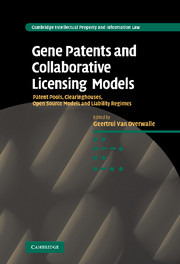 Gene Patents and Collaborative Licensing Models
Gene Patents and Collaborative Licensing Models Book contents
- Frontmatter
- Contents
- List of contributors
- Preface
- Foreword: Jean-Jacques Cassiman
- List of abbreviations
- Part I Patent pools
- Part II Clearinghouses
- 5 Clearinghouse mechanisms in genetic diagnostics. Conceptual framework
- 6 Case 3. The Global Biodiversity Information Facility (GBIF). An example of an information clearinghouse
- 7 Case 4. BirchBob. An example of a technology exchange clearing house
- 8 Case 5. The Public Intellectual Property Resource for Agriculture (PIPRA). A standard license public sector clearinghouse for agricultural IP
- 9 Case 6. The Science Commons Material Transfer Agreement Project. A standard licence clearinghouse?
- 10 Case 7. The collective management of copyright and neighbouring rights. An example of a royalty collection clearinghouse
- 11 Comment on the conceptual framework for a clearinghouse mechanism
- Part III Open source models
- Part IV Liability regimes
- Part V Different perspectives
- Part VI Summary and concluding analysis
- Index
- Titles in the series
5 - Clearinghouse mechanisms in genetic diagnostics. Conceptual framework
from Part II - Clearinghouses
Published online by Cambridge University Press: 14 January 2010
- Frontmatter
- Contents
- List of contributors
- Preface
- Foreword: Jean-Jacques Cassiman
- List of abbreviations
- Part I Patent pools
- Part II Clearinghouses
- 5 Clearinghouse mechanisms in genetic diagnostics. Conceptual framework
- 6 Case 3. The Global Biodiversity Information Facility (GBIF). An example of an information clearinghouse
- 7 Case 4. BirchBob. An example of a technology exchange clearing house
- 8 Case 5. The Public Intellectual Property Resource for Agriculture (PIPRA). A standard license public sector clearinghouse for agricultural IP
- 9 Case 6. The Science Commons Material Transfer Agreement Project. A standard licence clearinghouse?
- 10 Case 7. The collective management of copyright and neighbouring rights. An example of a royalty collection clearinghouse
- 11 Comment on the conceptual framework for a clearinghouse mechanism
- Part III Open source models
- Part IV Liability regimes
- Part V Different perspectives
- Part VI Summary and concluding analysis
- Index
- Titles in the series
Summary
Background
Both the existence and exploitation of human gene patents have gained wide attention. Although the controversy about the eligibility of patents in the field of human genetics remains, this primarily ethical debate has largely been ‘outlawed’ by the political international consensus to allow the registration of such patents as long as the general patentability requirements are fulfilled. Nevertheless, the voice of opponents of human gene patents is still regularly heard at various platforms and echoed in legislative proposals at both sides of the Atlantic. It remains to be seen to what extent this will actually lead to a reopening of the patentability debate and ultimately amendments in the patent legislation and granting policies. Some people would probably even argue that the policy of the patent offices actually already became more restrictive with regard to gene patents. In this paper I do not explicitly deal with the desirability of gene patents, rigorous application of patentability standards and patent scope, although I do recognize that these issues are intrinsically connected with the subject of this paper. However, as these topics are not the principal focus of this book, we will start from the status quo where gene patents have been and are granted globally and we will focus on the problems that granted patents might create with respect to their exploitation.
Moreover, clearinghouses are part of a spectrum of solutions which may remedy the problems described below. Research exemptions, compulsory licences and clearinghouses are just three of them.
- Type
- Chapter
- Information
- Gene Patents and Collaborative Licensing ModelsPatent Pools, Clearinghouses, Open Source Models and Liability Regimes, pp. 63 - 119Publisher: Cambridge University PressPrint publication year: 2009
- 4
- Cited by


